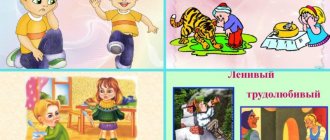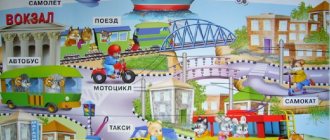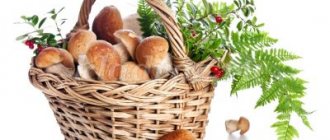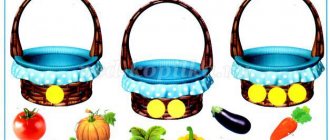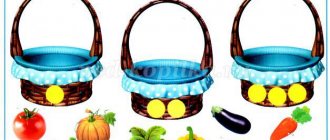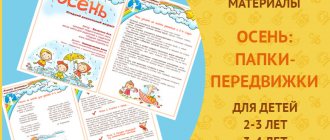Game-activity “Autumn” for children 3 years of age
Summary of a lesson in a playful way for children of the third year of life, topic: “Autumn”
Author: Davydova Svetlana Alekseevna.
Equipment:
Autumn leaves large and small. Leaves of yellow, red and green colors cut out of cardboard and vases (trays, bags, etc.) of the same colors. Puddles cut out of oilcloth. Nuts, a “squirrel” toy, a plastic bottle with a “hollow” cut out. Plasticine in yellow, red and green colors, sheets of paper with a painted tree. Wooden spatulas with red, yellow, green clothespins attached to them. Flowers and flower beds cut from egg cages, finger paints. Glue, sheets of paper with a background “autumn, tree trunks without a crown). Musical children's instruments. Audio recordings: “Waltz of the Flowers” by P. I. Tchaikovsky, song “Autumn, autumn has come, the leaves are falling.”
Didactic game “Summer or Autumn”
Target:
consolidate knowledge of the signs of autumn, differentiating them from the signs of summer; develop memory, speech; nurturing dexterity.
Progress of the game
: The teacher and children stand in a circle. Educator. If the leaves turn yellow, this is... (and throws the ball to one of the children. The child catches the ball and says, throwing it back to the teacher: “Autumn”).
Educator. If the birds fly away, this is ..... Etc.
31. Didactic game “Be careful”
Target:
differentiation of winter and summer clothing; develop auditory attention, speech hearing; increasing vocabulary.
Listen carefully to the verses about clothing, so that you can then list all the names that appear in these verses. Call it summer first. And then winter.
32. Didactic game “Take - don’t take”
Target
: differentiation of forest and garden berries; increasing vocabulary on the topic “Berries”; develop auditory attention.
Progress of the game
: Children stand in a circle. The teacher explains that he will pronounce the names of forest and garden berries. If children hear the name of a wild berry, they should sit down, and if they hear the name of a garden berry, they should stretch, raising their arms up.
Strawberries, blackberries, gooseberries, cranberries, red currants, strawberries, black currants, lingonberries, raspberries.
33. Didactic game “What do they plant in the garden?”
Target
: learn to classify objects according to certain characteristics (according to their place of growth, according to their use); develop quick thinking and auditory attention.
Progress of the game:
Children, do you know what they plant in the garden? Let's play this game: I will name different objects, and you listen carefully. If I name something that is planted in the garden, you will answer “Yes,” but if something that does not grow in the garden, you will say “No.” Whoever makes a mistake leaves the game.
- Carrots (yes), cucumber (yes), plums (no), beets (yes), etc.
Didactic game “Who will collect it most quickly?”
Target:
teach children to group vegetables and fruits; cultivate quick reaction to the teacher’s words, endurance and discipline.
Progress of the game
: Children are divided into two teams: “Gardeners” and “Gardeners”. On the ground there are models of vegetables and fruits and two baskets. At the command of the teacher, the teams begin to collect vegetables and fruits, each in their own basket. Whoever collects first raises the basket up and is considered the winner.
Didactic game “Who needs what?”
Target
: exercise in the classification of objects, the ability to name things necessary for people of a certain profession; develop attention.
Educator: - Let's remember what people of different professions need to work. I will name his profession, and you will tell him what he needs for work.
The teacher names a profession, the children say what is needed for work. And then in the second part of the game, the teacher names the object, and the children say for what profession it might be useful.
Didactic game “Make no mistake”
Target:
consolidate children's knowledge about different sports, develop resourcefulness, intelligence, attention; cultivate a desire to play sports.
Progress of the game
: The teacher lays out cut pictures depicting various sports: football, hockey, volleyball, gymnastics, rowing. There is an athlete in the middle of the picture; you need to select everything he needs for the game.
Using this principle, you can make a game in which children will select tools for various professions. For example, a builder: he needs tools - a shovel, trowel, paint brush, bucket; machines that make the work of a builder easier - a crane, an excavator, a dump truck, etc. The pictures show people of those professions that children are introduced to throughout the year: a cook, a janitor, a postman, a salesman, a doctor, a teacher, a tractor driver, a mechanic, etc. They select images of the objects of their labor. The correctness of execution is controlled by the picture itself: from small pictures it should turn into a large, whole one.
37. Didactic game “Guess it!”
Target:
learn to describe an object without looking at it, identify essential features in it, recognize an object by description; develop memory, speech.
Progress of the game
: At the teacher’s signal, the child who received the chip stands up and makes a description of any object from memory, and then passes the chip to the person who will guess. Having guessed, the child describes his item, passes the chip to the next one, etc.
38. Didactic game “Finish the sentence”
Target
: learn to complete sentences with a word of the opposite meaning; develop memory, speech.
Progress of the game
: The teacher begins a sentence, and the children finish it, only they say words that are opposite in meaning.
Sugar is sweet and pepper is... (bitter)
In summer the leaves are green, and in autumn - ..... (yellow)
The road is wide and the path is…. (narrow)
The ice is thin, but the trunk is ... (thick)
39. Didactic game “Where is what?”
Target:
learn to identify words with a given sound from a group of words, from a speech stream; consolidate the correct pronunciation of certain sounds in words; develop attention.
Progress of the game:
The teacher names the object and asks the children to answer where they can put it. For example:
- “Mom brought bread and put it in ... (breadbox).
- Masha poured sugar... Where? (Into the sugar bowl)
- Vova washed his hands and put the soap...Where? (On a soapbox)
40. Didactic game “Catch up with your shadow”
Target:
introduce the concept of light and shadow; develop speech.
Progress of the game
: Educator: Who will guess the riddle?
I'm going - she's going,
I'm standing - she's standing
If I run, she runs. Shadow
On a sunny day, if you stand with your face, back or side to the sun, a dark spot will appear on the ground, this is your reflection, it is called a shadow. The sun sends its rays to the earth, they spread in all directions. Standing in the light, you block the path of the sun's rays, they illuminate you, but your shadow falls on the ground. Where else is there shade? What does it look like? Catch up with the shadow. Dance with the shadow.
41. Didactic game “Finish the sentence”
Target
: learn to complete sentences with a word of the opposite meaning; develop memory, speech.
Progress of the game:
The teacher begins the sentence, and the children finish it, only they say words that are opposite in meaning.
Sugar is sweet and pepper is... (bitter)
In summer the leaves are green, and in autumn - ..... (yellow)
The road is wide and the path is…. (narrow)
The ice is thin, but the trunk is ... (thick)
Didactic games on the theme of autumn for preschoolers
Especially for children of preschool and primary school age, I have selected activities on the theme of autumn. They can be used both in kindergarten and at home.
All autumn games can be divided into several parts:
- A story about autumn (using cards, we compose a story about autumn together with the baby or on our own),
- logic exercises
- exercises to develop attention
- object sorting exercises
- games with flowers
- puzzles on the theme of autumn
- math fall games.
Autumn-themed story: Using thematic cards about autumn, compose a story with your child.
Thematic cards
You can download cards on the theme of autumn here - click on the pictures below and print them:
Pictures and tasks
the second option is a story about autumn with hand-drawn pictures - to download pictures on the theme of autumn for free, click on them:
A game to develop fine motor skills of the fingers on the theme of autumn - you need to circle the dotted line from the broom to the leaves:
Autumn games - here you need to sort into two columns - apples in one, leaves in the other:
Here you need to find the shadow of the object and connect the cards with each other:
We learn to sort leaves into large, medium and small:
Learning to count on the theme of autumn:
Puzzle with a stuffed animal - cut into pieces and put together with your child:
Puzzle with a squirrel is a more complex logic autumn game:
Autumn coloring - here you need to circle the acorn using the dots with numbers, and then color it:
Logical game on the theme of autumn - here you need to select an extra object in each line:
Another autumn game for sorting leaves by shade.
Print, cut into cards and sort from light to dark and vice versa:
Didactic games for children about AUTUMN
October 10, 2017
The purpose of didactic games is the process of teaching children some knowledge and skills.
It's autumn outside, which means it's time for educational games for children about this wonderful time of year.
I offer you several such games for preschool and primary school children.
To play you need a ball.
An adult throws a ball to the child and names a tree.
The child returns the ball, while forming a phrase by adding an adjective to the name of the tree.
- birch - golden birch,
- oak - mighty oak,
- larch - red larch,
- spruce - prickly spruce...
Didactic game “Autumn Signs”
Construct of conducting educational activities in sensitive moments during production practice
PM 02. “Organization of various types of activities and communication of children”
Desyatnikova Anastasia Vyacheslavovna, student of group 33B
Specialty 02/44/01. "Preschool education"
Date of:
13.10.20
DOO:
MBDOU "Kindergarten No. 73"
Age group:
Middle group
Educator:
Natalya Anatolyevna, Tatyana Mikhailovna
Methodist:
Temereva Lyudmila Petrovna
Educational area:
cognitive development; artistic and aesthetic development, speech development
Form of organization:
group
Activities
: didactic game “Autumn Signs”
Didactic task
: Consolidate knowledge about the signs of autumn, develop oral speech, observation, attention, memory.
Game task
: Teach the doll Katya to play the game “Autumn Signs”
Game rules
: Play together, wait your turn, help each other, be attentive, do not overdrink the person answering
Game actions:
Examination, pronouncing, correlating signs and seasons, making a proposal based on the picture.
Target:
Formation of cognitive interests, development of the ability to analyze and compare during the game activity “Autumn Signs”. Development of an understanding of the signs of autumn (leaf fall, harvesting, bird migration, rain, mushrooms, etc.)
Planned results:
children show interest in joint play activities;
children cooperate, help each other;
children develop oral speech in the process of implementing a game task;
children analyze the pictures and compare, in the process of implementing the game task, they find a suitable place on the playing field
children have ideas about the signs of autumn (leaf fall, harvesting, bird migration, rain, mushrooms, etc.)
| TASKS educational program | Tasks taking into account the individual characteristics of group students |
| 1. Educational tasks : cultivate interest in joint gaming activities develop the ability to cooperate and help each other. 2.Developmental tasks: develop children’s oral speech in the process of implementing a game task; develop mental operations: analysis, comparison, in the process of implementing a game task. 3.Learning tasks: enrich ideas about the signs of autumn (leaf fall, harvesting, bird migration, rain, mushrooms, etc.) |
Principles of preschool education (FSES):
building educational activities based on the individual characteristics of each child, in which the child himself becomes active in choosing the content of his education, becomes the subject of education;
assistance and cooperation of children and adults, recognition of the child as a full participant (subject) of educational relations;
